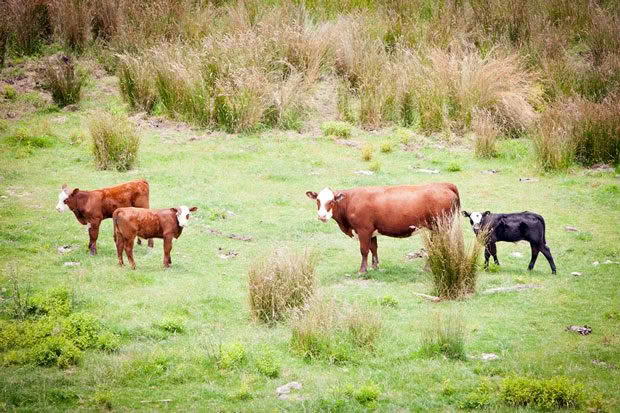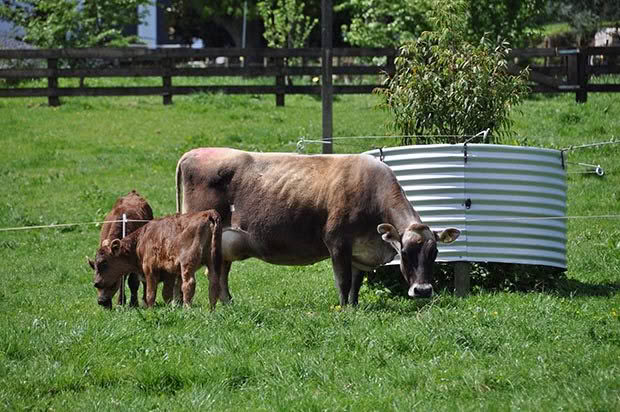10 Tips for Cattle in Winter

Calving time can come any time of the year on a small farm so it pays to be prepared.
Words: Dr Clive Dalton
Spring means calving time, but on small blocks cows can calve all year round as it’s often difficult to isolate bulls when they’re not needed.
That’s why it’s good to always be ready for surprises, with the calving gear ready and your vet’s contact number in your phone. Early veterinary assistance is essential, which means you need one if it’s been 30 minutes after a calf’s feet are showing and there’s no further progress. Vets don’t like being called hours after your helpful neighbour has failed, so get onto it pronto.
Cows suckling more than one calf need extra feed, and often concentrate supplements too, especially if you want to get them back in calf within the normal season. Check their teats for damage from calves’ teeth, and watch for swollen quarters not being suckled, as it could be mastitis. Suckled calves should be growing well in excess of 1kg/day.
It’s time for calf rearers to get into gear, and there are warnings for first timers who imagine big profits to be made from running dairy weaners. Don’t buy more than 10 calves, and buy them direct from one farmer. Buying a few at a time from saleyards risks disease, and the high possibility that they are from large herds that have not had enough colostrum at birth.
Don’t pay silly prices for early calves either. Buy once the spring flush is over, and always do a detailed budget – including your labour charges – to see if it’s worthwhile before you do anything.
Dairy weaner sales start in October in the North Island. Buying these calves (on a cents/kg live weight basis) is often a better profit option than rearing your own. Only buy weaners that have been properly dehorned with a cauterising iron, as dehorning will add to your costs later. Never dehorn with caustic paste, and use an anaesthetic around the horn bud. Consult your veterinarian about this.
Bull calves/weaners need to be castrated with rubber rings before six weeks of age. The market for bulls is usually better than steers, but you don’t want to run bulls on a small block. Young weaner/rising yearling bulls will be very keen to work and can get cows pregnant, despite the big difference in size.

Dairy weaners on good pasture should gain at least 1kg/day without meal. Meal is costly so it should only be fed if needed. If growth is poor, contact your veterinarian, as there must be a health problem in the calves.
If young stock are scouring, talk to your vet before buying drench (oral or pour-on) as the problem may not be worms. Also check what vaccinations calves will need, eg blackleg and other clostridial diseases.
Well-grown calves and rising yearlings (especially with dairy genes) will come on heat, so watch they don’t get in calf until they have reached their target weight. Any calves getting pregnant need to be aborted under veterinary supervision, as this will negatively affect their later productive life. All tiny calves from young small animals are best euthanased and not reared.
Bull sales start in October in the North Island, so sort out what you may need for the herd. Consider leasing before buying, as permanent bulls on small blocks are always a hazard. Any bulls used in previous seasons need to be vet checked.
Check that bulls running with cows are working properly, and that cows are not returning to oestrus. If cows are not holding to service, then consult your veterinarian for prompt action as every cycle missed delays calving next year by at least three weeks.
Artificial insemination may be a good option, but it can be expensive if it involves vet visits for hormone treatment to get cows to cycle before insemination. Without this you have to rely on your heat detection skills to know when the cow is going off heat (and is ovulating) for best insemination success. Get help with this from your AI supplier (or cattle farming neighbour) before mating starts so you know what signs to look for.
Cattle drink a lot of water (mature lactating cows 70-100 litres/day), so provide plenty of good quality water and keep troughs clean. Mature cattle should not need to be drenched for worms. Avoid at all costs using pour-ons on young stock as a routine in the assumption that they need regular worm treatment, as this is now the major cause of the increasing drench resistance in cattle worms.
Lice can be a problem in spring, especially on thin animals, so get an appropriate treatment from your vet.
Tips:
- Get all gear ready for calving in good time. Seek early veterinary help when needed.
- Have plenty of colostrum available to provide at least 2 litres in the first 6 hours of life. Treat navels with iodine at birth, and repeat in wet muddy conditions.
- If you have not reared calves before, start in a small way. Calves need a warm, dry but well ventilated shed in the first few weeks.
- Don’t drench young calves for worms, but do check them for lice.
- Always have good supplements ready for cows in case there’s a ‘feed pinch’.
- Cows suckling more than one calf will need extra meal as they are milking heavily, which will delay oestrus
- Keep checking udders for quarters not being milked out, and damage to teats.
- Don’t feed out old mouldy silage or hay to any stock; use it for garden compost or mulch.
- When feeding pasture supplements, make sure they are not being wasted.
- Stand cattle off onto a dry area after heavy rain on a proper feed pad (which complies with effluent disposal rules).
- Double check voltage on the boundary fence to prevent unwelcome visits by a neighbouring bull.
- Castrate all bull calves before 6 weeks old with rubber rings.
- Dehorn all calves before 6 weeks old using an anaesthetic, and only buy calves that have been properly disbudded.
Love this story? Subscribe now!
 This article first appeared in NZ Lifestyle Block Magazine.
This article first appeared in NZ Lifestyle Block Magazine.
